Multidimensional Human Responses Under Dynamic Spectra of Daylighting and Electric Lighting
Abstract
1. Introduction
1.1. Electric Light Visually Replaces Daylight
1.2. Differences Between Daylighting and Electric Lighting
1.3. The Purpose of This Study
2. Methods
2.1. Experiment Conditions
2.2. Experimental Scheme
2.2.1. Visual Performance Indicators
2.2.2. Physiological Indicators
- Critical flicker frequency (CFF)
- 2.
- Electrocardiogram (ECG)
2.2.3. Psychological Indicators
2.3. Participants
2.4. Data Analysis
3. Results
3.1. Visual Performance
3.2. Physiological Responses
3.2.1. CFF Results
3.2.2. HRV Results
3.3. Questionnaire Evaluation
3.4. Relations Among Different Tasks
4. Discussion
4.1. The Consistency Between Visual Effects and Non-Visual Effects
4.2. The Influence of Other Factors on HRV
4.3. Limitations and Prospects
5. Conclusions
- DLED can achieve the same effect as DL in this experiment. Under DLED lighting, subjects showed better visual performance, physiological measurement results, and higher subjective evaluation scores, indicating that subjects were in a better overall working state. In contrast, subjects performed the worst under CLED lighting. The analysis of the reasons shows that DLED has good lighting uniformity and the full spectrum.
- The lighting effect does not improve with an increase in horizontal illuminance on the work surface. A horizontal illuminance level of 500 lx showed the best performance across visual performance, physiological effects, and subjective evaluation. If artificial indoor luminous environments are created, 500 lx of horizontal illuminance is the optimal choice.
- There is a significant correlation between visual performance, physiological effects, and subjective evaluations, with a certain degree of synergy observed between visual and non-visual effects in the experimental results. In particular, the correlation between CFF difference and lighting preference reached –0.614 **. When testing visual performance and physiological indicators is not feasible, subjective evaluations can provide an effective analysis of the lighting environment.
Author Contributions
Funding
Data Availability Statement
Conflicts of Interest
References
- de Kort, Y.A.W. Tutorial: Theoretical Considerations When Planning Research on Human Factors in Lighting. LEUKOS 2019, 15, 85–96. [Google Scholar] [CrossRef]
- Rastegari, E.; Adamsson, M.; Aries, M. Daylight potential of Swedish residential environments: Visual and beyond-vision effects and the relationship with well-being assessment. Light. Res. Technol. 2024, 57, 14771535241268606. [Google Scholar] [CrossRef]
- Besenecker, U.C.; Krueger, T. Luminous Color in Architecture: Exploring Methodologies for Design-Relevant Research. Enq. ARCC J. Archit. Res. 2015, 12, 35–46. [Google Scholar] [CrossRef]
- Zielinska-Dabkowska, K.M.; Hartmann, J.; Sigillo, C. LED light sources and their complex set-up for visually and biologically effective illumination for ornamental indoor plants. Sustainability 2019, 11, 2642. [Google Scholar] [CrossRef]
- Smolders, K.; De Kort, Y.A.W.; Cluitmans, P.J.M. A higher illuminance induces alertness even during office hours: Findings on subjective measures, task performance and heart rate measures. Physiol. Behav. 2012, 107, 7–16. [Google Scholar] [CrossRef]
- Shishegar, N.; Boubekri, M. Natural Light and Productivity: Analyzing the Impacts of Daylighting on Students’ and Workers’ Health and Alertness. In Proceedings of the International Conference on “Health, Biological and Life Science”(HBLS-16), Istanbul, Turkey, 14–15 April 2016; pp. 18–19. [Google Scholar]
- Jamrozik, A.; Clements, N.; Hasan, S.S.; Zhao, J.; Zhang, R.; Campanella, C.; Loftness, V.; Porter, P.; Ly, S.; Wang, S. Access to daylight and view in an office improves cognitive performance and satisfaction and reduces eyestrain: A controlled crossover study. Build. Environ. 2019, 165, 106379. [Google Scholar] [CrossRef]
- Lucas, R.J.; Peirson, S.N.; Berson, D.M.; Brown, T.M.; Cooper, H.M.; Czeisler, C.A.; Figueiro, M.G.; Gamlin, P.D.; Lockley, S.W.; O’Hagan, J.B. Measuring and using light in the melanopsin age. Trends Neurosci. 2014, 37, 1–9. [Google Scholar] [CrossRef]
- Knoop, M.; Stefani, O.; Bueno, B.; Matusiak, B.; Hobday, R.; Wirz-Justice, A.; Martiny, K.; Kantermann, T.; Aarts, M.; Zemmouri, N.; et al. Daylight: What makes the difference? Light. Res. Technol. 2020, 52, 423–442. [Google Scholar] [CrossRef]
- Rockcastle, S.; Andersen, M. Measuring the dynamics of contrast & daylight variability in architecture: A proof-of-concept methodology. Build. Environ. 2014, 81, 320–333. [Google Scholar]
- Tabadkani, A.; Roetzel, A.; Li, H.X.; Tsangrassoulis, A. Daylight in buildings and visual comfort evaluation: The advantages and limitations. J. Daylight. 2021, 8, 181–203. [Google Scholar] [CrossRef]
- Shi, J.; Liang, Q.; Jin, L.; Luo, T.; Yang, B.; Pan, Q.; Zhang, S.; Xue, P. Different human physical responses of visual performance within daylighting and artificial lighting. J. Build. Eng. 2025, 101, 111886. [Google Scholar] [CrossRef]
- Linhart, F.; Scartezzini, J.-L. Evening office lighting–visual comfort vs. energy efficiency vs. performance? Build. Environ. 2011, 46, 981–989. [Google Scholar] [CrossRef]
- Dai, C.; Li, N.; Shah, A.H.; Lin, Y. Human Perception and Preferences of Evening Office Lighting in Terms of the LED Spectrum. In Proceedings of the 2021 18th China International Forum on Solid State Lighting & 2021 7th International Forum on Wide Bandgap Semiconductors (SSLChina: IFWS), Shenzhen, China, 26–28 October 2021; pp. 194–197. [Google Scholar]
- Jiang, Z.; Zhu, Y.; Wang, Y.; Wei, Y. Research on Indoor Health Lighting Design Based on Silicon Substrate Golden Light LED Technology. Buildings 2025, 15, 932. [Google Scholar] [CrossRef]
- Figueiro, M.G.; Steverson, B.; Heerwagen, J.; Kampschroer, K.; Hunter, C.M.; Gonzales, K.; Plitnick, B.; Rea, M.S. The impact of daytime light exposures on sleep and mood in office workers. Sleep Health 2017, 3, 204–215. [Google Scholar] [CrossRef]
- Liang, Q.; Jin, L.; Luo, T.; Shi, J.; Xue, P.; Liu, J.; Wang, B.; Jin, X. Status of Typical Artificial Lighting Environments in Different Public Buildings in China, and Requirements for Their Improvement. Buildings 2023, 13, 2283. [Google Scholar] [CrossRef]
- Konstantzos, I.; Sadeghi, S.A.; Kim, M.; Xiong, J.; Tzempelikos, A. The effect of lighting environment on task performance in buildings—A review. Energy Build. 2020, 226, 110394. [Google Scholar] [CrossRef]
- Rizvi, S.I.; Majumdar, G. Introduction to Circadian Rhythms. In Circadian Clock and Aging; Springer Nature: Singapore, 2024; pp. 1–29. ISBN 978-981-9766-94-9. [Google Scholar]
- Brainard, G.C.; Hanifin, J.P.; Greeson, J.M.; Byrne, B.; Glickman, G.; Gerner, E.; Rollag, M.D. Action Spectrum for Melatonin Regulation in Humans: Evidence for a Novel Circadian Photoreceptor. J. Neurosci. 2001, 21, 6405–6412. [Google Scholar] [CrossRef]
- Cajochen, C.; Zeitzer, J.M.; Czeisler, C.A.; Dijk, D.-J. Dose-response relationship for light intensity and ocular and electroencephalographic correlates of human alertness. Behav. Brain Res. 2000, 115, 75–83. [Google Scholar] [CrossRef]
- Smolders, K.C.H.J.; de Kort, Y.A.W. Bright light and mental fatigue: Effects on alertness, vitality, performance and physiological arousal. J. Environ. Psychol. 2014, 39, 77–91. [Google Scholar] [CrossRef]
- Noor, M.C.; Saradj, F.M.; Yazdanfar, S.-A. Analytical evolution of measurement methods for light’s non-visual effects. Results Eng. 2023, 17, 100922. [Google Scholar] [CrossRef]
- Lockley, S.W.; Brainard, G.C.; Czeisler, C.A. High Sensitivity of the Human Circadian Melatonin Rhythm to Resetting by Short Wavelength Light. J. Clin. Endocrinol. Metab. 2003, 88, 4502–4505. [Google Scholar] [CrossRef] [PubMed]
- Khademagha, P.; Aries, M.B.C.; Rosemann, A.L.P.; van Loenen, E.J. Implementing non-image-forming effects of light in the built environment: A review on what we need. Build. Environ. 2016, 108, 263–272. [Google Scholar] [CrossRef]
- Jin, L.; Xue, P.; Zhang, L.; Wang, J.; Shi, J.; Liang, Q.; Cao, X.; Xu, N.; Liao, J. Visual and non-visual effects of integrated lighting based on spectral information. Build. Environ. 2023, 242, 110617. [Google Scholar] [CrossRef]
- Milner, T.E.; Anvari, B.; Smolensky, M.H. Editorial: ChronoBiophotonics. Front. Photonics 2024, 5, 1529091. [Google Scholar] [CrossRef]
- Souman, J.L.; Borra, T.; De Goijer, I.; Schlangen, L.J.M.; Vlaskamp, B.N.S.; Lucassen, M.P. Spectral Tuning of White Light Allows for Strong Reduction in Melatonin Suppression without Changing Illumination Level or Color Temperature. J. Biol. Rhythm. 2018, 33, 420–431. [Google Scholar] [CrossRef]
- Castilla, N.; Blanca-Giménez, V.; Pérez-Carramiñana, C.; Llinares, C. Differences between Daylighting and Electric Lighting in Affective Response. Buildings 2024, 14, 770. [Google Scholar] [CrossRef]
- Wahl, S.; Engelhardt, M.; Schaupp, P.; Lappe, C.; Ivanov, I.V. The inner clock—Blue light sets the human rhythm. J. Biophotonics 2019, 12, e201900102. [Google Scholar] [CrossRef]
- Aguado-Delgado, J.; de-Pablos-Heredero, C.; Otón, S. Evaluation and Improvement of Lighting Efficiency in Working Spaces. Sustain. Light. Light. Sustain. 2021, 12, 1110. [Google Scholar]
- Vetter, C.; Pattison, P.M.; Houser, K.; Herf, M.; Phillips, A.J.K.; Wright, K.P.; Skene, D.J.; Brainard, G.C.; Boivin, D.B.; Glickman, G. A Review of Human Physiological Responses to Light: Implications for the Development of Integrative Lighting Solutions. LEUKOS 2022, 18, 387–414. [Google Scholar] [CrossRef]
- Münch, M.; Kobialka, S.; Steiner, R.; Oelhafen, P.; Wirz-Justice, A.; Cajochen, C. Wavelength-dependent effects of evening light exposure on sleep architecture and sleep EEG power density in men. Am. J. Physiol.-Regul. Integr. Comp. Physiol. 2006, 290, R1421–R1428. [Google Scholar] [CrossRef]
- Potočnik, J.; Košir, M. The necessity for multi-spectral simulations of the indoor non-visual luminous environment: A simplified annual approach. Buildings 2023, 13, 1357. [Google Scholar] [CrossRef]
- Chellappa, S.L.; Steiner, R.; Blattner, P.; Oelhafen, P.; Götz, T.; Cajochen, C. Non-visual effects of light on melatonin, alertness and cognitive performance: Can blue-enriched light keep us alert? PLoS ONE 2011, 6, e16429. [Google Scholar] [CrossRef] [PubMed]
- Gagné, V.; Turgeon, R.; Jomphe, V.; Demers, C.M.; Hébert, M. Evaluation of the effects of blue-enriched white light on cognitive performance, arousal, and overall appreciation of lighting. Front. Public Health 2024, 12, 1390614. [Google Scholar] [CrossRef] [PubMed]
- Motamedzadeh, M.; Golmohammadi, R.; Kazemi, R.; Heidarimoghadam, R. The effect of blue-enriched white light on cognitive performances and sleepiness of night-shift workers: A field study. Physiol. Behav. 2017, 177, 208–214. [Google Scholar] [CrossRef]
- Veitch, J.A.; Stokkermans, M.G.M.; Newsham, G.R. Linking Lighting Appraisals to Work Behaviors. Environ. Behav. 2013, 45, 198–214. [Google Scholar] [CrossRef]
- Goudjil, A.; Pigeon, E.; Pouliquen, M.; Girard, S.; Menard, T.; Gehan, O.; Dufay, B.; Maugars, P.; Paris, J.-M. Optimized closed-loop algorithm for color control of multichannel LED lighting systems using multispectral sensor. Opt. Eng. 2020, 59, 053104. [Google Scholar] [CrossRef]
- Van Bommel, W. Human-Centric Lighting. In Encyclopedia of Color Science and Technology; Shamey, R., Ed.; Springer International Publishing: Cham, Switzerland, 2023; pp. 907–910. ISBN 978-3-030-89861-8. [Google Scholar]
- Hertog, W. The Design and Implementation of a Spectrally Tuneable LED-Based Light Sourde: Towards a New Era of Intelligent Illumination; Universitat Politècnica de Catalunya: Barcelona, Spain, 2017. [Google Scholar]
- Cauwerts, C. Influence of Presentation Modes on Visual Perceptions of Daylit Spaces; Université catholique de Louvain (UCL): Louvain-la-Neuve, Belgium, 2013. [Google Scholar]
- Alhammadi, H.; Amer, S.T. Work Productivity and Human Wellbeing in Offices Using Natural Light Vs Artificial Light. In Proceedings of the 5th European International Conference on Industrial Engineering and Operations Management, Rome, Italy, 26–28 July 2022. [Google Scholar]
- Mahmoud, N.S.A.; El Samanoudy, G.; Jung, C. Simulating the natural lighting for a physical and mental Well-being in residential building in Dubai, UAE. Ain Shams Eng. J. 2023, 14, 101810. [Google Scholar] [CrossRef]
- Morales-Bravo, J.; Navarrete-Hernandez, P. Enlightening wellbeing in the home: The impact of natural light design on perceived happiness and sadness in residential spaces. Build. Environ. 2022, 223, 109317. [Google Scholar] [CrossRef]
- Collier, J.M.; Wilkerson, A.; Durmus, D.; Rodriguez-Feo Bermudez, E. Studying Response to Light in Offices: A Literature Review and Pilot Study. Buildings 2023, 13, 471. [Google Scholar] [CrossRef]
- CIE S 026:2018; CIE System for Metrology of Optical Radiation for ipRGC-Influenced Responses to Light. Commission Internationale de l’Éclairage: Vienna, Austria, 2018.
- CIE TN 003:2015; Report on the First International Workshop on Circadian and Neurophysiological Photometry. Commission Internationale de l’Éclairage: Vienna, Austria, 2015.
- UNE EN 12464-1:2022; Light and Lighting—Lighting of Work Places—Part 1: Indoor Work Places. European Committee for Standardization: Brussels, Belgium, 2022.
- The Lighting Handbook, 11th ed.; Illuminating Engineering Society of North America: New York, NY, USA, 2022.
- WELL Building Standard v2; International WELL Building Institute: New York, NY, USA, 2020.
- Cajochen, C.; Freyburger, M.; Basishvili, T.; Garbazza, C.; Rudzik, F.; Renz, C.; Kobayashi, K.; Shirakawa, Y.; Stefani, O.; Weibel, J. Effect of daylight LED on visual comfort, melatonin, mood, waking performance and sleep. Light. Res. Technol. 2019, 51, 1044–1062. [Google Scholar] [CrossRef]
- Shaffer, F.; Ginsberg, J.P. An overview of heart rate variability metrics and norms. Front. Public Health 2017, 5, 258. [Google Scholar] [CrossRef]
- Taelman, J.; Vandeput, S.; Spaepen, A.; Van Huffel, S. Influence of Mental Stress on Heart Rate and Heart Rate Variability. In Proceedings of the 4th European Conference of the International Federation for Medical and Biological Engineering, Antwerp, Belgium, 23–27 November 2008; Vander Sloten, J., Verdonck, P., Nyssen, M., Haueisen, J., Eds.; IFMBE Proceedings. Springer: Berlin/Heidelberg, Germany, 2009; Volume 22, pp. 1366–1369, ISBN 978-3-540-89207-6. [Google Scholar]
- Jiang, A.; Yao, X.; Westland, S.; Hemingray, C.; Foing, B.; Lin, J. The effect of correlated colour temperature on physiological, emotional and subjective satisfaction in the hygiene area of a space station. Int. J. Environ. Res. Public Health 2022, 19, 9090. [Google Scholar] [CrossRef] [PubMed]
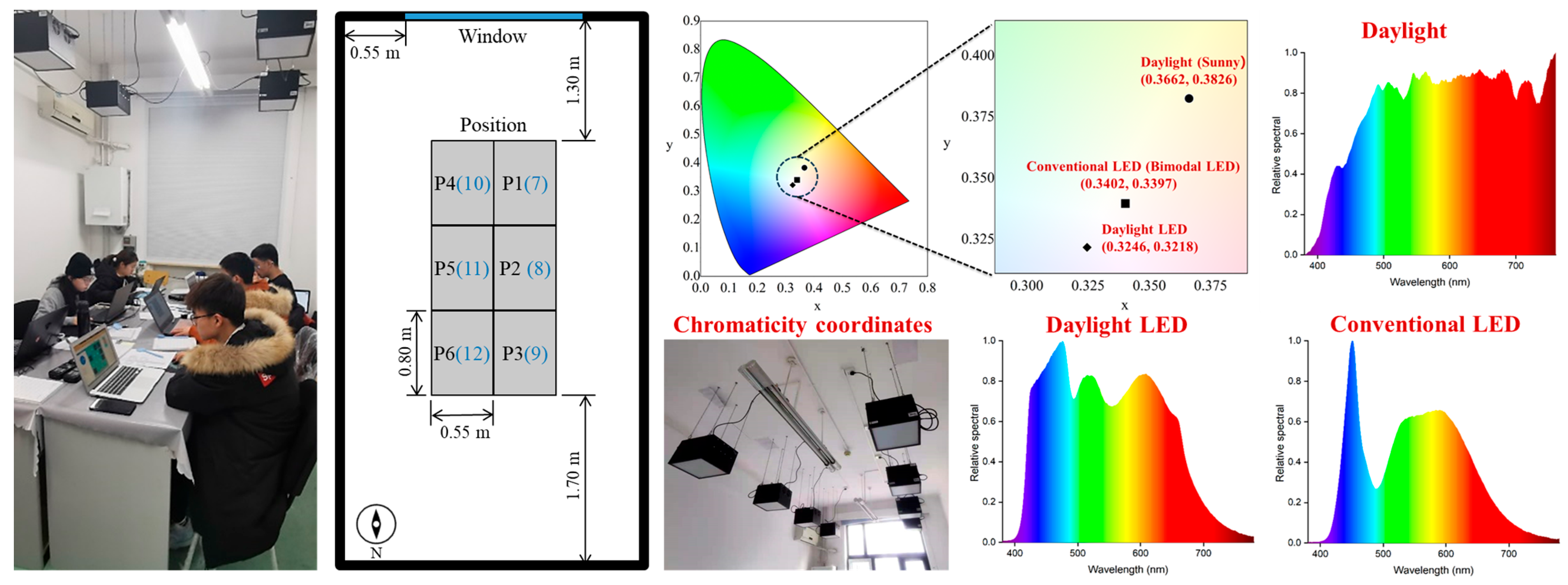
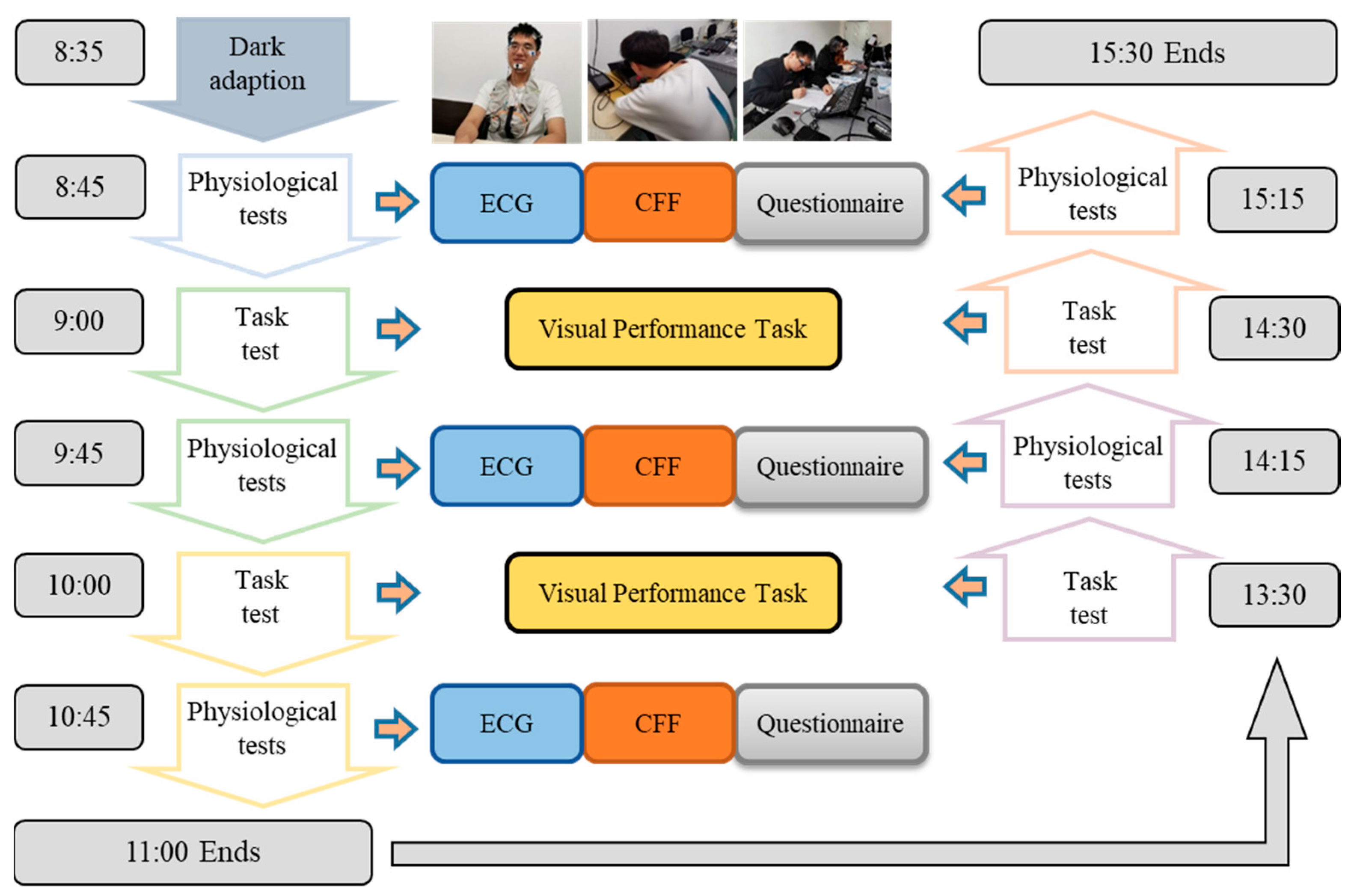
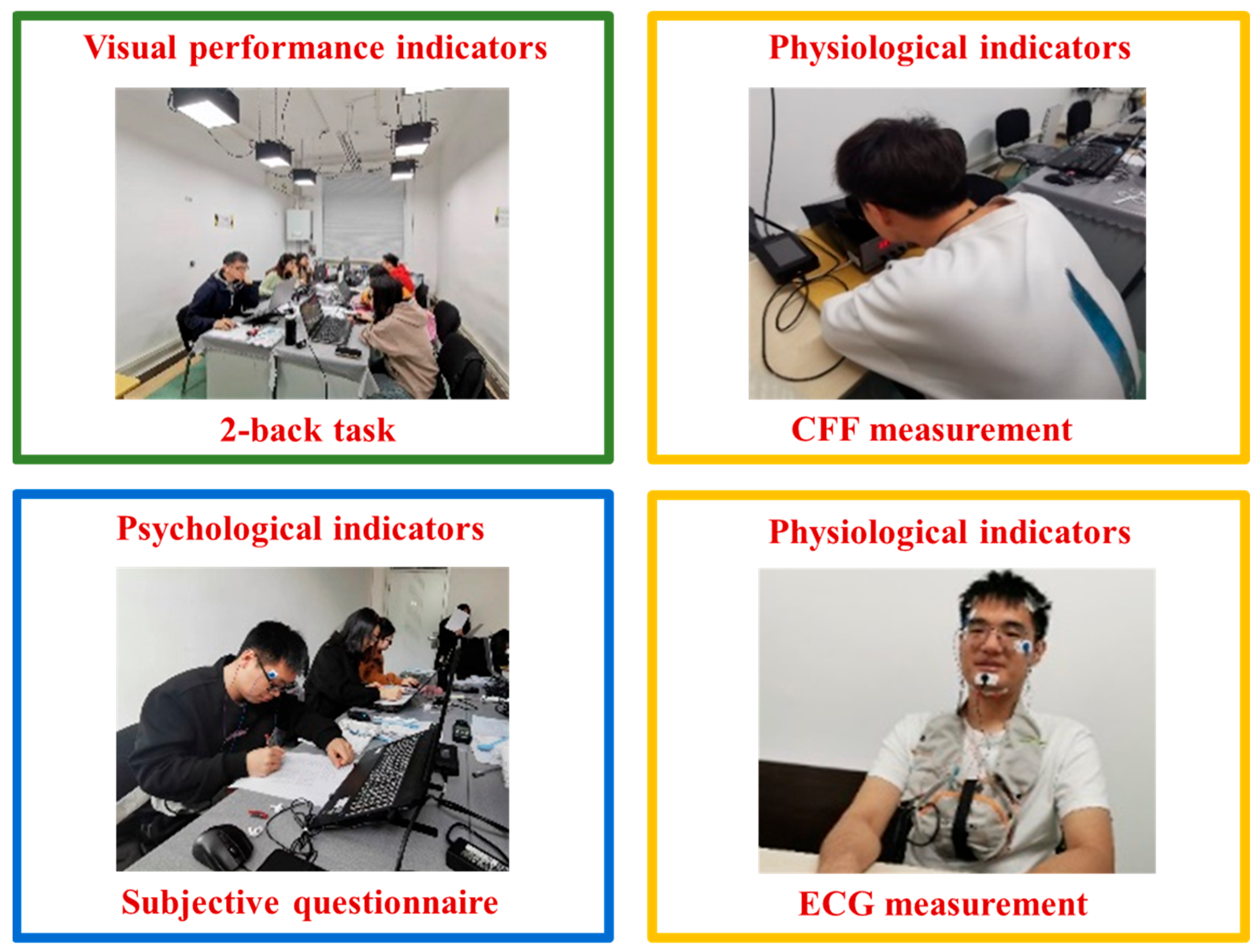
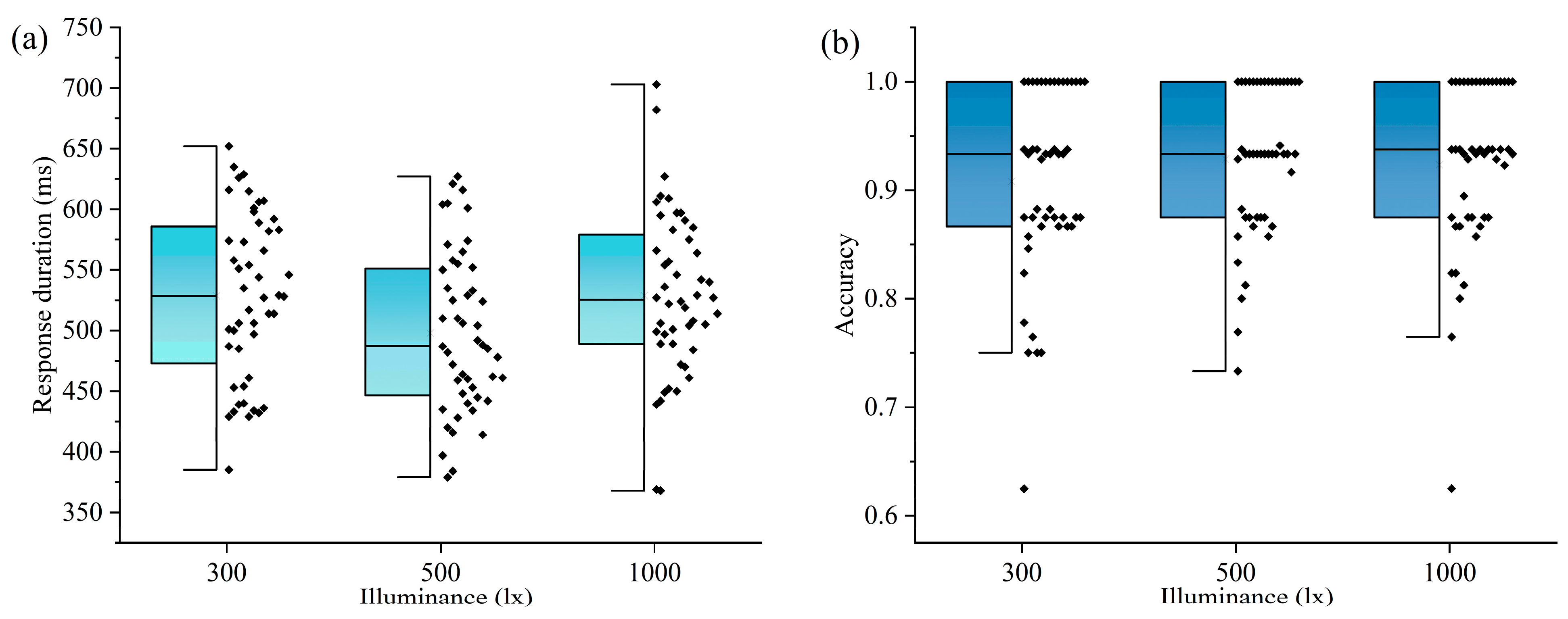
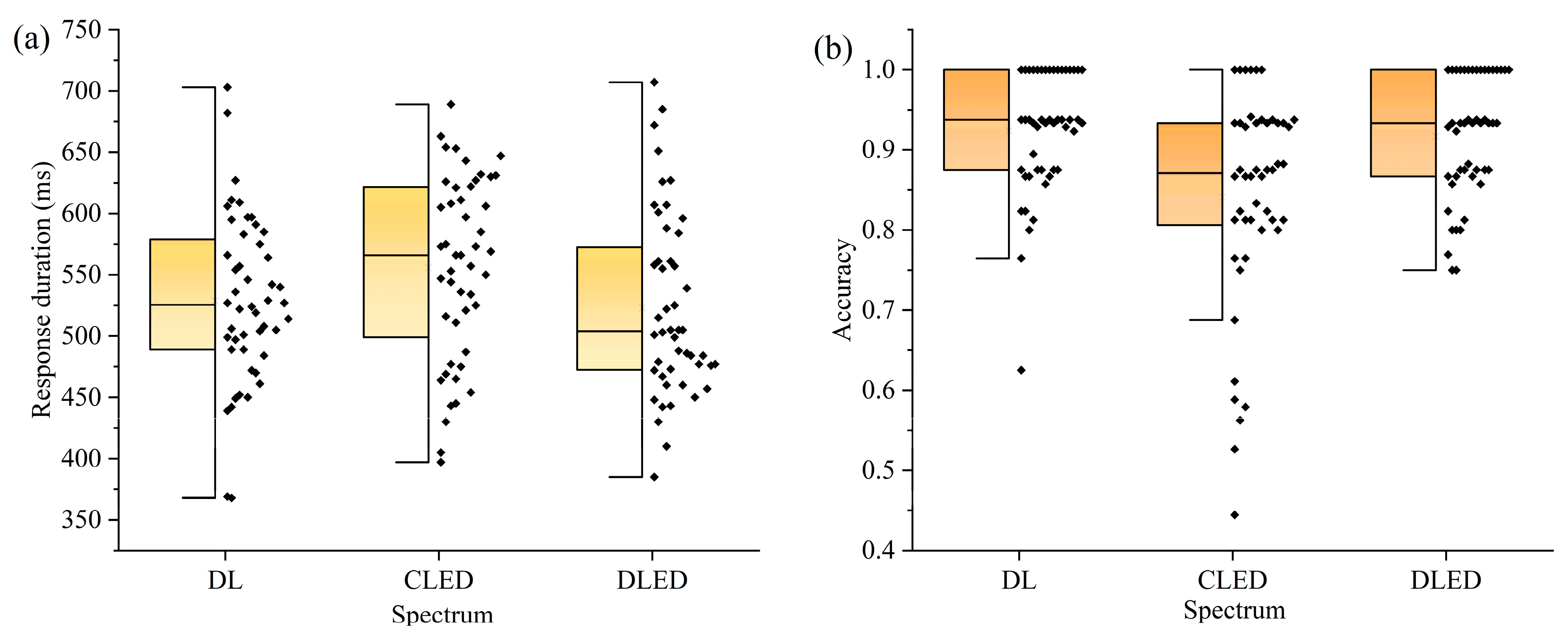









| Alertness | Room Lighting | Dark/Bright | Cold/Warm | Uniformity of Illuminance | Discomfort from Glare | Work Efficiency | Eye Fatigue | CFF Difference | ||
|---|---|---|---|---|---|---|---|---|---|---|
| 2-back accuracy | R | 0.019 | 0.021 | 0.081 | 0.014 | 0.229 * | 0.046 | 0.082 | 0.071 | −0.097 |
| p | 0.692 | 0.665 | 0.092 | 0.779 | 0.007 | 0.337 | 0.09 | 0.193 | 0.405 | |
| 2-back speed | R | 0.365 ** | 0.386 ** | 0.004 | −0.112 | −0.407 ** | −0.303 ** | 0.388 ** | 0.462 ** | 0.311 ** |
| p | 0.001 | 0.047 | 0.942 | 0.02 | 0.001 | 0.000 | 0.003 | 0.001 | 0.004 | |
| CFF difference | R | 0.326 ** | 0.614 ** | −0.233 | −0.225 | −0.354 ** | −0.448 ** | 0.347 ** | 0.535 ** | / |
| p | 0.004 | 0.001 | 0.488 | 0.601 | 0.000 | 0.000 | 0.004 | 0.000 | / |
Disclaimer/Publisher’s Note: The statements, opinions and data contained in all publications are solely those of the individual author(s) and contributor(s) and not of MDPI and/or the editor(s). MDPI and/or the editor(s) disclaim responsibility for any injury to people or property resulting from any ideas, methods, instructions or products referred to in the content. |
© 2025 by the authors. Licensee MDPI, Basel, Switzerland. This article is an open access article distributed under the terms and conditions of the Creative Commons Attribution (CC BY) license (https://creativecommons.org/licenses/by/4.0/).
Share and Cite
Dong, Y.; Wu, G.; Shi, J.; Liang, Q.; Cui, Z.; Xue, P. Multidimensional Human Responses Under Dynamic Spectra of Daylighting and Electric Lighting. Buildings 2025, 15, 2184. https://doi.org/10.3390/buildings15132184
Dong Y, Wu G, Shi J, Liang Q, Cui Z, Xue P. Multidimensional Human Responses Under Dynamic Spectra of Daylighting and Electric Lighting. Buildings. 2025; 15(13):2184. https://doi.org/10.3390/buildings15132184
Chicago/Turabian StyleDong, Yingjun, Guiyi Wu, Jiaxin Shi, Qingxuan Liang, Zhipeng Cui, and Peng Xue. 2025. "Multidimensional Human Responses Under Dynamic Spectra of Daylighting and Electric Lighting" Buildings 15, no. 13: 2184. https://doi.org/10.3390/buildings15132184
APA StyleDong, Y., Wu, G., Shi, J., Liang, Q., Cui, Z., & Xue, P. (2025). Multidimensional Human Responses Under Dynamic Spectra of Daylighting and Electric Lighting. Buildings, 15(13), 2184. https://doi.org/10.3390/buildings15132184







